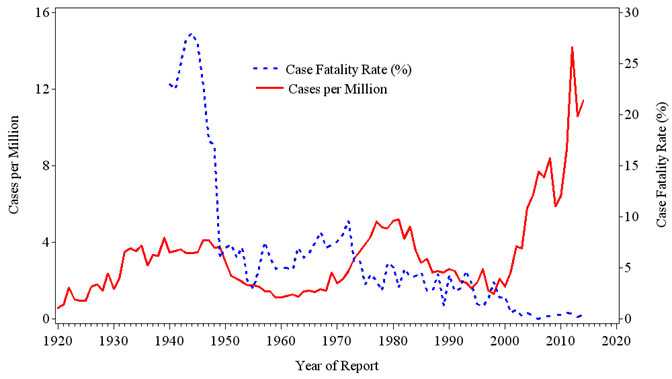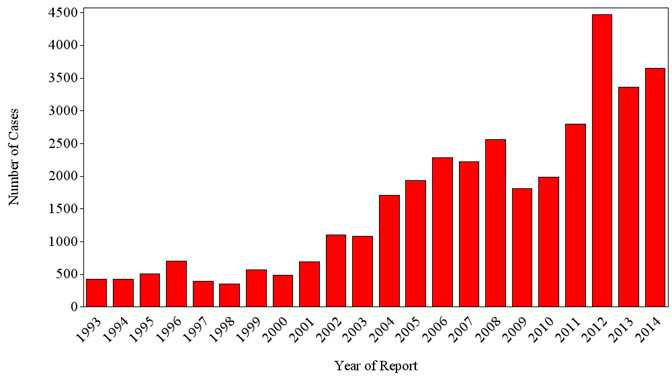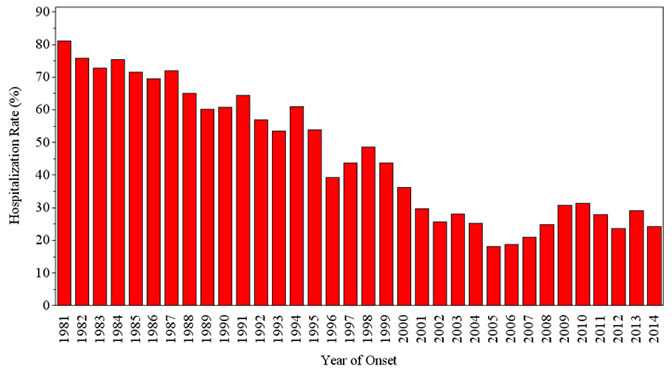Statistics and Epidemiology
Rocky Mountain spotted fever (RMSF) has been a nationally notifiable condition since the 1920s. As of January 1, 2010, cases of RMSF are reported under a new category called Spotted Fever Rickettsiosis (SFR). This category captures cases of RMSF, R. parkeri rickettsiosis, Pacific Coast tick fever, and rickettsialpox. The change reflects the inability to differentiate between spotted fever group Rickettsia species using commonly available serologic tests.
The incidence of SFR (the number of SFR cases for every million persons) has increased during the last decade, from less than 2 cases per million persons in 2000 to over 11 cases per million in 2014. During the same period, the proportion of SFR cases resulting in death, known as the case fatality rate, has dropped to less than 0.5%. Thousands of cases of spotted fever group rickettsiosis occur every year, but it is unclear how many of those cases are RMSF, and how many result from other, less severe spotted fevers. Inclusion of less severe spotted fevers, such as R. parkeri rickettsiosis, likely leads to the lower case fatality rate observed in recent decades.
Epidemiology Figure 1 – Reported incidence and case fatality of SFR in the United States, 1920–2014

Incidence and case fatality 1920-2014
Cases of SFR have been recorded since the 1920s. Trends in SFR incidence vary over time, but are generally increasing. Periods of increased incidence can be seen between 1930 and 1950 and 1968 through 1990. More recently, there has been a dramatic increase in incidence of SFR increasing from 1.7 cases per million persons in 2000 to an all-time high of 14.2 cases per million persons in 2012. Case fatality rates vary from year to year, but have had an overall decreasing trend from 28% case fatality in 1944 to less than 1% case fatality beginning in 2001.
Cases of Spotted Fever Rickettsiosis in the United States
Epidemiology Figure 2 – Number of US SFR cases reported to CDC, 1993–2014.

Number of SFR cases 1993-2014
The graph displays the number of human cases of SFR cases reported to CDC annually from 1993 through 2014. The number of cases of SFR reported to CDC per year have generally increased annually from 424 cases in 1993, to 4470 cases reported in 2012. Cases decreased in 2009 to 1791 cases and subsequently increased to an all-time high of 4470 cases reported in 2012.
Hospitalization Rate
Epidemiology Figure 3 – SFR cases by month of onset 1993 through 2014.

Although spotted fever infections with R. parkeri, R. philipii, and R. akari are typically mild and may not require treatment, cases of RMSF are frequently severe and require hospitalization when not treated early. Overall, hospitalization rates (proportion of cases that were hospitalized) have decreased from the 1980s; however, nearly 25% of reported patients with spotted fever infections are still hospitalized at some point during their illness.
Maps
SFR cases have been reported throughout the contiguous United States, although five states (North Carolina, Oklahoma, Arkansas, Tennessee, and Missouri) account for over 60% of SFR cases.
In eastern Arizona, RMSF cases have recently been identified in an area where the disease had not been previously seen. Between 2003 and 2014, nearly 320 cases had been reported with a case-fatality rate of about 10%. The tick responsible for transmission of R. rickettsii in Arizona is the brown dog tick (Rhipicephalus sanguineus sensu lato), which is found on dogs and around people’s homes. Almost all of the cases occurred within communities with a large number of free-roaming dogs.
Epidemiology Figure 4 – Incidence (per million population) for SFR in the United States for 2014. (NN= Not notifiable)

Geographic distribution of SFR incidence in 2014
This figure shows the reported incidence of SFR cases by state in 2014 per million persons. SFR was not notifiable in Alaska and Hawaii in 2014. The incidence rate was reportedly zero for the District of Columbia, Kansas, Michigan, Rhode Island, Vermont, and Wyoming. Incidence ranged between 0.1 to 1.0 case per million persons for California, Colorado, Idaho, Maryland, Nevada, Ohio, Pennsylvania, and Washington. Annual incidence ranged from 1.0 to 2.3 cases per million persons in Connecticut, Florida, Maine, Massachusetts, Minnesota, New Hampshire, New York, Oregon, Utah, and Wisconsin. Annual incidence ranged from 2.3 to 6.6 cases per million persons in Arizona, Georgia, Indiana, Iowa, Louisiana, Montana, New Jersey, North Dakota, South Carolina, South Dakota, Texas, and West Virginia. The highest incidence rates, ranging from 6.6 to 278 cases per million persons were found in Alabama, Arkansas, Delaware, Illinois, Kentucky, Mississippi, Missouri, Nebraska, North Carolina, Oklahoma, Tennessee, and Virginia.
Seasonal Trends
Although cases of SFR can occur during any month of the year, the majority of reported cases became ill during the summer months when ticks are most active, and a peak in cases typically occurs in the months of June and July. Seasonal trends may vary depending on the area of the country and tick species involved. In Arizona, where the majority of SFR cases are spread by the brown dog tick, cases occur year-round with peak months of illness onset April through October.
Epidemiology Figure 5 – SFR cases by month of onset 1993 through 2014

SFR cases by month of onset, 1993 through 2014
This figure shows the percent of cases reported from 1993 through 2014 by month of onset to demonstrate the seasonal trends of cases. There are cases reported in each month of the year, however most are reported between May and August. Roughly 20% of cases are reported in each June and July.
People at Risk
From a review of national surveillance data, cases of spotted fever rickettsiosis are more frequently reported in men than in women, American Indians report higher number of SFR infections than other race groups, and the majority of reported cases are among people at least 40 years old. Children under 10 years old, American Indians, people with a compromised immune system, and people who do not receive treatment within the first 5 days of illness are at an increased risk of death from SFR.
Epidemiology Figure 6 – Average annual incidence of SFR by age group, 2000 through 2014

Average annual incidence of spotted fever rickettsiosis by age-group, 2000 through 2014
This figure shows the average annual incidence of SFR per million persons by age groups for 2000 through 2014. The graph shows that cases have been reported in every age group with increased incidence as age increases. There is a slightly higher incidence rate in the 5-9 year old age group, which surpasses 4 cases per million persons. The highest incidence rate in observed in age groups 55-59 and 60-64 years old, both of which reported more than 10 cases per million persons.
- Page last reviewed: December 5, 2012
- Page last updated: May 18, 2017
- Content source:



 ShareCompartir
ShareCompartir